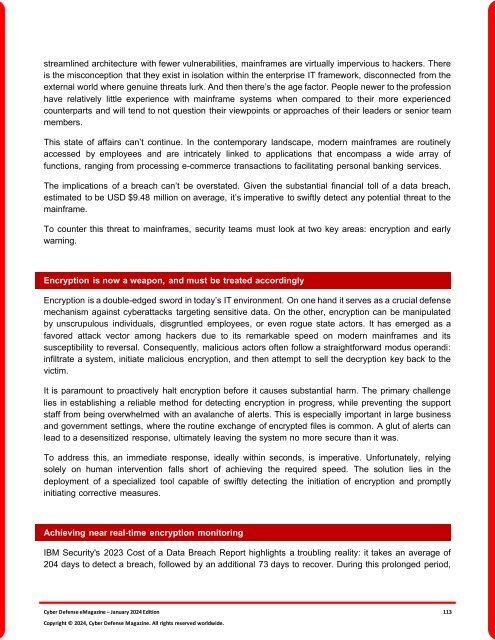The Cyber Defense eMagazine January Edition for 2024
Cyber Defense eMagazine January Edition for 2024 #CDM #CYBERDEFENSEMAG @CyberDefenseMag by @Miliefsky a world-renowned cyber security expert and the Publisher of Cyber Defense Magazine as part of the Cyber Defense Media Group as well as Yan Ross, Editor-in-Chief and many more writers, partners and supporters who make this an awesome publication! 201 page January Edition fully packed with some of our best content. Thank you all and to our readers! OSINT ROCKS! #CDM #CDMG #OSINT #CYBERSECURITY #INFOSEC #BEST #PRACTICES #TIPS #TECHNIQUES
Cyber Defense eMagazine January Edition for 2024 #CDM #CYBERDEFENSEMAG @CyberDefenseMag by @Miliefsky a world-renowned cyber security expert and the Publisher of Cyber Defense Magazine as part of the Cyber Defense Media Group as well as Yan Ross, Editor-in-Chief and many more writers, partners and supporters who make this an awesome publication! 201 page January Edition fully packed with some of our best content. Thank you all and to our readers! OSINT ROCKS! #CDM #CDMG #OSINT #CYBERSECURITY #INFOSEC #BEST #PRACTICES #TIPS #TECHNIQUES
You also want an ePaper? Increase the reach of your titles
YUMPU automatically turns print PDFs into web optimized ePapers that Google loves.
streamlined architecture with fewer vulnerabilities, mainframes are virtually impervious to hackers. <strong>The</strong>re<br />
is the misconception that they exist in isolation within the enterprise IT framework, disconnected from the<br />
external world where genuine threats lurk. And then there’s the age factor. People newer to the profession<br />
have relatively little experience with mainframe systems when compared to their more experienced<br />
counterparts and will tend to not question their viewpoints or approaches of their leaders or senior team<br />
members.<br />
This state of affairs can’t continue. In the contemporary landscape, modern mainframes are routinely<br />
accessed by employees and are intricately linked to applications that encompass a wide array of<br />
functions, ranging from processing e-commerce transactions to facilitating personal banking services.<br />
<strong>The</strong> implications of a breach can’t be overstated. Given the substantial financial toll of a data breach,<br />
estimated to be USD $9.48 million on average, it’s imperative to swiftly detect any potential threat to the<br />
mainframe.<br />
To counter this threat to mainframes, security teams must look at two key areas: encryption and early<br />
warning.<br />
Encryption is now a weapon, and must be treated accordingly<br />
Encryption is a double-edged sword in today’s IT environment. On one hand it serves as a crucial defense<br />
mechanism against cyberattacks targeting sensitive data. On the other, encryption can be manipulated<br />
by unscrupulous individuals, disgruntled employees, or even rogue state actors. It has emerged as a<br />
favored attack vector among hackers due to its remarkable speed on modern mainframes and its<br />
susceptibility to reversal. Consequently, malicious actors often follow a straight<strong>for</strong>ward modus operandi:<br />
infiltrate a system, initiate malicious encryption, and then attempt to sell the decryption key back to the<br />
victim.<br />
It is paramount to proactively halt encryption be<strong>for</strong>e it causes substantial harm. <strong>The</strong> primary challenge<br />
lies in establishing a reliable method <strong>for</strong> detecting encryption in progress, while preventing the support<br />
staff from being overwhelmed with an avalanche of alerts. This is especially important in large business<br />
and government settings, where the routine exchange of encrypted files is common. A glut of alerts can<br />
lead to a desensitized response, ultimately leaving the system no more secure than it was.<br />
To address this, an immediate response, ideally within seconds, is imperative. Un<strong>for</strong>tunately, relying<br />
solely on human intervention falls short of achieving the required speed. <strong>The</strong> solution lies in the<br />
deployment of a specialized tool capable of swiftly detecting the initiation of encryption and promptly<br />
initiating corrective measures.<br />
Achieving near real-time encryption monitoring<br />
IBM Security's 2023 Cost of a Data Breach Report highlights a troubling reality: it takes an average of<br />
204 days to detect a breach, followed by an additional 73 days to recover. During this prolonged period,<br />
<strong>Cyber</strong> <strong>Defense</strong> <strong>eMagazine</strong> – <strong>January</strong> <strong>2024</strong> <strong>Edition</strong> 113<br />
Copyright © <strong>2024</strong>, <strong>Cyber</strong> <strong>Defense</strong> Magazine. All rights reserved worldwide.

















